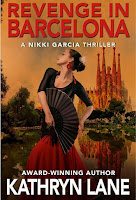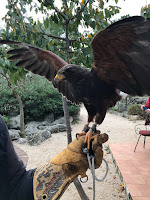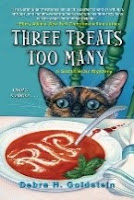Untitled Post
Pets in Fiction by Kathryn Lane
The book review section of the Wall
Street Journal recently featured an essay based on The Falcon Thief,
a “tale of adventure, treachery, and the hunt for the perfect bird”. The title
aroused my curiosity since a middle eastern character in my latest mystery
thriller, Revenge in Barcelona, gallantly tethers a Harris hawk
to a thick leather vest on his shoulder.
Street Journal recently featured an essay based on The Falcon Thief,
a “tale of adventure, treachery, and the hunt for the perfect bird”. The title
aroused my curiosity since a middle eastern character in my latest mystery
thriller, Revenge in Barcelona, gallantly tethers a Harris hawk
to a thick leather vest on his shoulder.
As I read Hammer’s essay, I pondered why
authors of novels and cozy mysteries include pets, especially feline and canine
types, in their fictional stories. Of course, tales of other animals – horses,
whales, elephants, chickens, and snakes have made it into print over the years.
authors of novels and cozy mysteries include pets, especially feline and canine
types, in their fictional stories. Of course, tales of other animals – horses,
whales, elephants, chickens, and snakes have made it into print over the years.
In the Taste Too Many series by
Debra H. Goldstein, a feisty Siamese, RahRah, plays a central role. Three cozy
mysteries strong, the alpha male RahRah has company starting in book two – a dog named Fluffy. RahRah occasionally gets jealous of his canine friend.
Debra H. Goldstein, a feisty Siamese, RahRah, plays a central role. Three cozy
mysteries strong, the alpha male RahRah has company starting in book two – a dog named Fluffy. RahRah occasionally gets jealous of his canine friend.
A few particularly perceptive pets
help solve crimes. Octo-Cat, a talking feline, helps a pet whisperer P.I. find
the guilty killers in Molly Fitz’s series. Unlike Octo-Cat, neither RahRah nor
Fluffy in Goldstein’s cozies manage human-speak, but they are fully supportive of
Sarah, the amateur sleuth.
help solve crimes. Octo-Cat, a talking feline, helps a pet whisperer P.I. find
the guilty killers in Molly Fitz’s series. Unlike Octo-Cat, neither RahRah nor
Fluffy in Goldstein’s cozies manage human-speak, but they are fully supportive of
Sarah, the amateur sleuth.
Margaret Mizushima’s Timber Creek,
a police procedural series with a K-9 German Shepard called Robo assists
Deputy Mattie Cobb in her investigative work.
a police procedural series with a K-9 German Shepard called Robo assists
Deputy Mattie Cobb in her investigative work.
Within the realm of fiction, most pets
are the adorable “best friend” type, as they are in real life. Even a K-9
handler becomes extremely close to her police dog. Cats have starred in poetry,
especially in children’s books, like T.S. Eliot’s Old Possum’s Book of
Practical Cats, the inspiration for Andrew Lloyd Webber’s Broadway
musical.
are the adorable “best friend” type, as they are in real life. Even a K-9
handler becomes extremely close to her police dog. Cats have starred in poetry,
especially in children’s books, like T.S. Eliot’s Old Possum’s Book of
Practical Cats, the inspiration for Andrew Lloyd Webber’s Broadway
musical.
People love pets. So it’s reasonable
to think that authors who bring a pet into a fictional book are imitating real
life. And that’s what a lot of fiction is about – making the story sound real.
Dumbo, the pink elephant, lets children suspend reality and accept Dumbo’s fantasy
world. Fantasy becomes the new reality.
to think that authors who bring a pet into a fictional book are imitating real
life. And that’s what a lot of fiction is about – making the story sound real.
Dumbo, the pink elephant, lets children suspend reality and accept Dumbo’s fantasy
world. Fantasy becomes the new reality.
However, The Falcon Thief,
by Joshua Hammer, is non-fiction. In Hammer’s book, birds of prey are not characters,
but victims of a cruel black market. The novel deals with a smuggler stealing
raptor eggs in South America for the Middle East market. The story also
ventures into the black market of other species, often endangered ones.
by Joshua Hammer, is non-fiction. In Hammer’s book, birds of prey are not characters,
but victims of a cruel black market. The novel deals with a smuggler stealing
raptor eggs in South America for the Middle East market. The story also
ventures into the black market of other species, often endangered ones.
In fiction, pets liven up a book,
entertain readers, and make the setting of the story warm and engaging. As I
learned in The Falcon Thief, non-fiction brings out another slice
of real life, crimes that are committed to make money by smuggling animals,
reptiles, and birds.
entertain readers, and make the setting of the story warm and engaging. As I
learned in The Falcon Thief, non-fiction brings out another slice
of real life, crimes that are committed to make money by smuggling animals,
reptiles, and birds.
Fiction is entertainment. Reading mysteries,
sci-fi, fantasy, or romance lets us escape our own routine lives and casts us
into a role where we become part of the protagonist’s world, participate in his
or her investigative escapade, imagine ourselves traveling to unknown
universes, envision the wonders of a magical voyage, or feel the passion of
romance.
sci-fi, fantasy, or romance lets us escape our own routine lives and casts us
into a role where we become part of the protagonist’s world, participate in his
or her investigative escapade, imagine ourselves traveling to unknown
universes, envision the wonders of a magical voyage, or feel the passion of
romance.
 As for my own writing, I will continue
As for my own writing, I will continueto pen suspense and mystery novels that include pets. My upcoming novel, Colonel’s Dilemma has a clowder of cats; Danger in the Coyote Zone (2nd edition coming in June) includes a crow, who like a parrot, has a limited vocabulary, and Shaheen, the Harris hawk of my latest thriller, Revenge in Barcelona, does not talk, but loves to hunt.
Biography
Originally from Mexico, Kathryn Lane was
an artist in her early years. To earn a living, she became a certified public
accountant and embarked on a career in international finance with a major
multinational corporation. She left the corporate world to plunge into writing mystery
and suspense thrillers. In her stories, Kathryn draws deeply from her Mexican background as well as her travels
in over ninety countries.
an artist in her early years. To earn a living, she became a certified public
accountant and embarked on a career in international finance with a major
multinational corporation. She left the corporate world to plunge into writing mystery
and suspense thrillers. In her stories, Kathryn draws deeply from her Mexican background as well as her travels
in over ninety countries.
All
photos are by the author, except for:
photos are by the author, except for:
Dumbo
(Unknown author, Creative Commons at creativecommons.org)
(Unknown author, Creative Commons at creativecommons.org)






